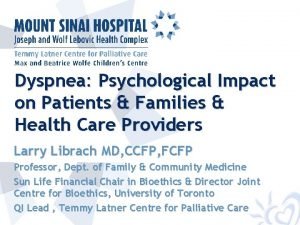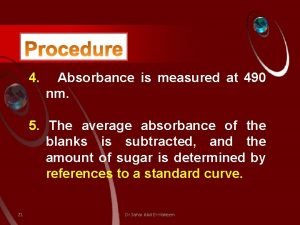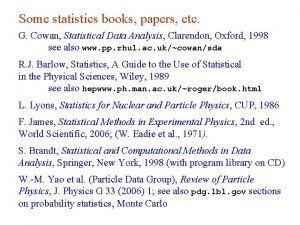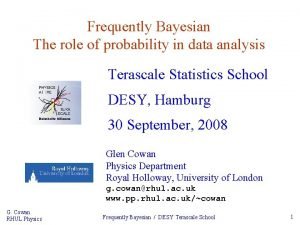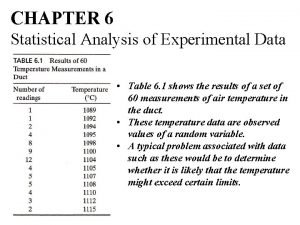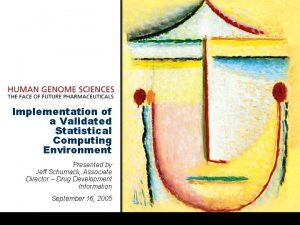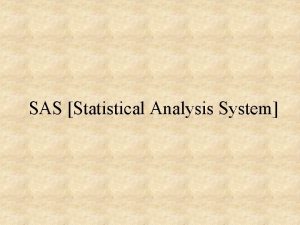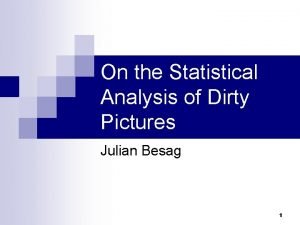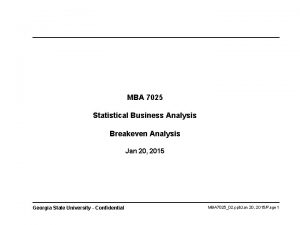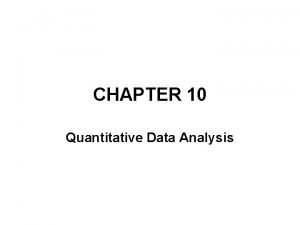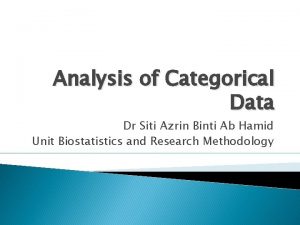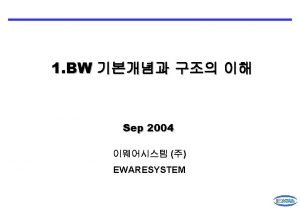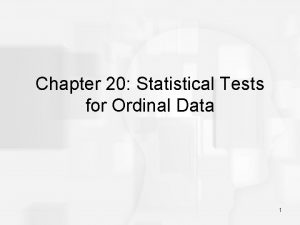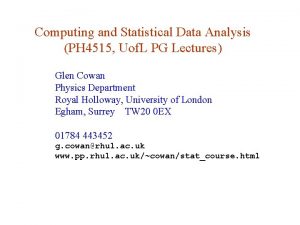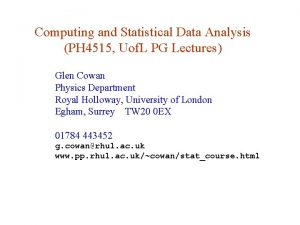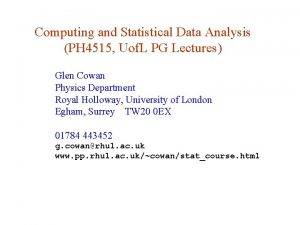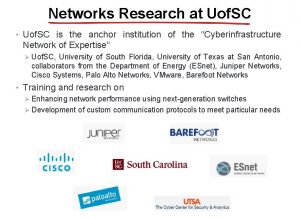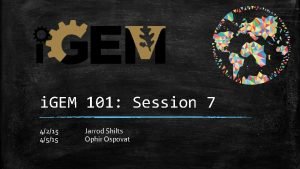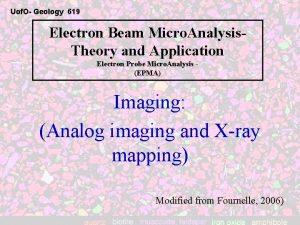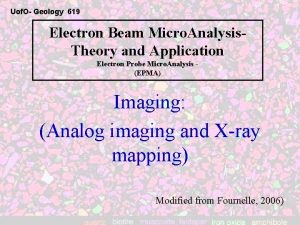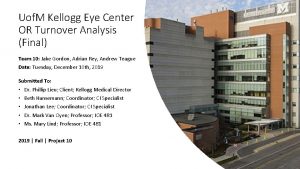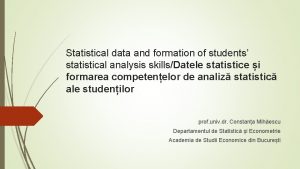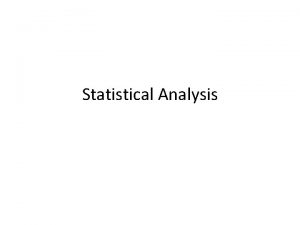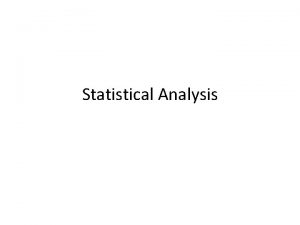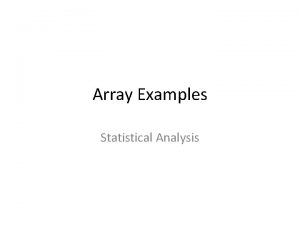Computing and Statistical Data Analysis PH 4515 Uof





















- Slides: 21

Computing and Statistical Data Analysis (PH 4515, Uof. L PG Lectures) Glen Cowan Physics Department Royal Holloway, University of London Egham, Surrey TW 20 0 EX 01784 443452 g. cowan@rhul. ac. uk www. pp. rhul. ac. uk/~cowan/stat_course. html Glen Cowan RHUL Physics Computing and Statistical Data Analysis

Outline 1 st 4 weeks will be a crash course in C++ Quick overview of the important stuff Use UNIX (Linux) environment Intro to tools like ROOT, gmake, debugger From around week 5, statistical data analysis Probability, random variables, Monte Carlo methods Statistical tests Parameter estimation Data analysis exercises will use C++ tools Glen Cowan RHUL Physics Computing and Statistical Data Analysis

Coursework, exams, etc. For C++ part Computer based exercises -- see course web site. For data analysis part More exercises, many computer based For PH 4515 students Written exam at end of year (70% of mark), no questions on C++, only statistical data analysis. For Ph. D students No material from this course in exam Glen Cowan RHUL Physics Computing and Statistical Data Analysis

C++ Outline Approximately by lecture for 1 st 4 weeks: 1 2 3 4 5 6 7 8 Glen Cowan RHUL Physics Introduction to C++ and UNIX environment Variables, types, expressions Loops, type casting, functions Files and streams Arrays, strings, pointers Classes, intro to Object Oriented Programming Memory allocation, operator overloading, templates Inheritance, STL, gmake, ddd Computing and Statistical Data Analysis

Some resources (computing part) There are many web based resources, e. g. , www. doc. ic. ac. uk/~wjk/C++Intro (Rob Miller, IC course) www. cplus. com (online reference) See links on course site or google for “C++ tutorial”, etc. There are thousands of books – see e. g. W. Savitch, Problem Solving with C++, 4 th edition (lots of detail – very thick). B. Stroustrup, The C++ Programming Language (the classic – even thicker). Lippman, Lajoie (& Moo), C++ Primer, A-W, 1998. Glen Cowan RHUL Physics Computing and Statistical Data Analysis

Introduction to UNIX/Linux We will learn C++ using the Linux operating system Open source, quasi-free version of UNIX and C developed ~1970 at Bell Labs Short, cryptic commands: cd, ls, grep, … Other operating systems in 1970 s, 80 s ‘better’, (e. g. VMS) but, fast ‘RISC processors’ in early 1990 s needed a cheap solution → we got UNIX In 1991, Linus Torvalds writes a free, open source version of UNIX called Linux. We currently use the distribution from CERN Glen Cowan RHUL Physics Computing and Statistical Data Analysis

Basic UNIX tasks divide neatly into: interaction between operating system and computer (the kernel), interaction between operating system and user (the shell). Several shells (i. e. command sets) available: sh, csh, tcsh, bash, … Shell commands typed at a prompt, here [linappserv 1]~> often set to indicate name of computer: Command pwd to “print working directory”, i. e. , show the directory (folder) you’re sitting in. Glen Cowan RHUL Physics Computing and Statistical Data Analysis

UNIX file structure Tree-like structure for files and directories (like folders): ← the ‘root’ directory / usr/ bin/ smith/ WWW/ Glen Cowan RHUL Physics home/ sys/ jones/ code/ tmp/ . . . jackson/. . . thesis/ . . . Computing and Statistical Data Analysis

Simple UNIX file tricks A complete file name specifies the entire ‘path’ /home/jones/thesis/chapter 1. tex A tilde points to the home directory: ~/thesis/chapter 1. tex ← the logged in user (e. g. jones) ~smith/analysis/result. dat ← a different user Single dot points to current directory, two dots for the one above: /home/jones/thesis ← current directory . . /code ← same as /home/jones/code Glen Cowan RHUL Physics Computing and Statistical Data Analysis

A few UNIX commands (case sensitive!) pwd ls ls -la man ls man -k keyword cd mkdir foo cd. . rmdir foo xemacs foo & more foo less foo rm foo Glen Cowan RHUL Physics Show present working directory List files in present working directory List files of present working directory with details Show manual page for ls. Works for all commands. Searches man pages for info on “keyword”. Change present working directory to home directory. Create subdirectory foo Change to subdirectory foo (go down in tree) Go up one directory in tree Remove subdirectory foo (must be empty) Edit file foo with XEmacs (& to run in background) Display file foo (space for next page) Similar to more foo, but able to back up (q to quit) Delete file foo Computing and Statistical Data Analysis

A few more UNIX commands cp foo bar mv foo bar lpr foo ps kill 345. /foo ctrl-c chmod ug+x foo Copy file foo to file bar, e. g. , cp ~smith/foo. / copies Smith’s file foo to my current directory Rename file foo to bar Print file foo. Use -P to specify print queue, e. g. , lpr -Plj 1 foo (site dependent). Show existing processes Kill process 345 (kill -9 as last resort) Run executable program foo in current directory Terminate currently executing program Change access mode so user and group have privilege to execute foo (Check with ls -la) Better to read a book or online tutorial and use man pages Glen Cowan RHUL Physics Computing and Statistical Data Analysis

UNIX file access If you type ls –la, you will see that each file and directory is characterized by a set of file access rights: Three groups of letters refer to: user (u), group (g) and other (o). The possible permissions are read (r), write (w), execute (x). By default, everyone in your group will have read access to all of your files. To change this, use chmod, e. g. chmod go-rwx hgg prevents group and other from seeing the directory hgg. Glen Cowan RHUL Physics Computing and Statistical Data Analysis

Introduction to C++ Language C developed (from B) ~ 1970 at Bell Labs Used to create parts of UNIX C++ derived from C in early 1980 s by Bjarne Stroustrup “C with classes”, i. e. , user-defined data types that allow “Object Oriented Programming”. Java syntax based largely on C++ (head start if you know java) C++ is case sensitive (a not same as A). Currently most widely used programming language in High Energy Physics and many other science/engineering fields. Recent switch after four decades of FORTRAN. Glen Cowan RHUL Physics Computing and Statistical Data Analysis

Compiling and running a simple C++ program Using, e. g. , xemacs, create a file Hello. World. cc containing: // My first C++ program #include <iostream> using namespace std; int main(){ cout << "Hello World!" << endl; return 0; } We now need to compile the file (creates machine-readable code): g++ -o Hello. World. cc Invokes compiler (gcc) Run the program: Glen Cowan RHUL Physics name of output file. /Hello. World Hello World! source code ← you type this ← computer shows this Computing and Statistical Data Analysis

Notes on compiling/linking g++ -o Hello. World. cc is an abbreviated way of saying first g++ -c Hello. World. cc Compiler (-c) produces Hello. World. o. Then ‘link’ the object file(s) with (‘object files’) g++ -o Hello. World. o If the program contains more than one source file, list with spaces; use to continue to a new line: g++ -o Hello. World. cc Bonjour. cc Gruess. Gott. cc Yo. Dude. cc Glen Cowan RHUL Physics Computing and Statistical Data Analysis

Writing programs in the Real World Usually create a new directory for each new program. For trivial programs, type compile commands by hand. For less trivial but still small projects, create a file (a ‘script’) to contain the commands needed to build the program: #!/bin/sh # File build. sh to build Hello. World g++ -o Hello. World. cc Bonjour. cc Gruess. Gott. cc Yo. Dude. cc To use, must first have ‘execute access’ for the file: chmod ug+x build. sh. /build. sh Glen Cowan RHUL Physics ← do this only once ← executes the script Computing and Statistical Data Analysis

A closer look at Hello. World. cc // My first C++ program is a comment (preferred style) The older ‘C style’ comments are also allowed (cannot be nested): /* These lines here are comments */ /* and so are these */ You should include enough comments in your code to make it understandable by someone else (or by yourself, later). Each file should start with comments indicating author’s name, main purpose of the code, required input, etc. Glen Cowan RHUL Physics Computing and Statistical Data Analysis

More Hello. World. cc − include statements #include <iostream> is a compiler directive. Compiler directives start with #. These statements are not executed at run time but rather provide information to the compiler. tells the compiler that the code will use library routines whose definitions can be found in a file called iostream, usually located somewhere under /usr/include #include <iostream> Old style was #include <iostream. h> contains functions that perform i/o operations to communicate with keyboard and monitor. iostream In this case, we are using the iostream object cout to send text to the monitor. We will include it in almost all programs. Glen Cowan RHUL Physics Computing and Statistical Data Analysis

More Hello. World. cc using namespace std; More later. For now, just do it. A C++ program is made up of functions. Every program contains exactly one function called main: int main(){ // body of program goes here return 0; } Functions “return” a value of a given type; main returns int (integer). The () are for arguments. Here main takes no arguments. The body of a function is enclosed in curly braces: { return 0; Glen Cowan RHUL Physics } means main returns a value of 0. Computing and Statistical Data Analysis

Finishing up Hello. World. cc The ‘meat’ of Hello. World is contained in the line cout << "Hello World!" << endl; Like all statements, it ends with a semi-colon. cout is an “output stream object”. You send strings (sequences of characters) to cout with << We will see it also works for numerical quantities (automatic conversion to strings), e. g. , cout << "x = " << x << endl; Sending endl to cout indicates a new line. (Try omitting this. ) Old style was "Hello World!n" Glen Cowan RHUL Physics Computing and Statistical Data Analysis

Wrapping up lecture 1 We have seen just enough UNIX to get started. Try out the commands from the lecture and have a look at the online tutorials. We have seen how to compile and run the simplest possible C++ program. Log in, enter the code into a file and get it to run. If you can’t get it to work, shout for help. Try entering the compile commands into a short script and build the program in this way. Later we will see a more elegant (read: cryptic) way of building larger programs with a utility called gmake. Next lecture: variables, types, expressions Glen Cowan RHUL Physics Computing and Statistical Data Analysis
 Höh uof lg
Höh uof lg üof
üof üof
üof üof
üof Polish leasing association
Polish leasing association Preserving statistical validity in adaptive data analysis
Preserving statistical validity in adaptive data analysis Cowan statistical data analysis
Cowan statistical data analysis Cowan statistical data analysis pdf
Cowan statistical data analysis pdf Statistical analysis of experimental data
Statistical analysis of experimental data Statistical computing environment
Statistical computing environment Conventional computing and intelligent computing
Conventional computing and intelligent computing Statistical analysis system
Statistical analysis system On the statistical analysis of dirty pictures
On the statistical analysis of dirty pictures Multivariate statistical analysis
Multivariate statistical analysis Statistical business analysis
Statistical business analysis Conjoint analysis in r
Conjoint analysis in r Data collection in research example
Data collection in research example What statistical test for categorical data
What statistical test for categorical data Statistical data warehouse
Statistical data warehouse T test ordinal data
T test ordinal data Statistical treatment
Statistical treatment Define data collection method
Define data collection method


